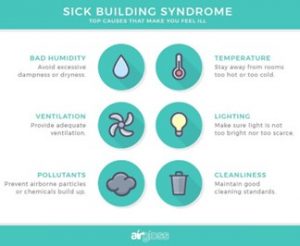Sick Building Syndrome

What is Sick Building Syndrome?
People are spending more time indoors, and creating an indoor environment that focuses on their health and safety is vital. Employees spend approximately ⅓ of their day in the office, exposed to many changing, potentially harmful conditions.(1) With this risk of poor working conditions, such as high IAQ, comes the rise of Sick Building Syndrome. Sick Building Syndrome “comprises various nonspecific symptoms that occur in the occupants of a building.”(1) Sick Building Syndrome can be used to describe a situation in which those who are in a building feel unwell or discomfort that seems to be caused by the time they spend in the building. Although the cause is unknown, it is believed to be mainly attributed to poor ventilation.(2)
How to Tell The Signs
In the US, approximately 1 in 4 are experiencing Sick Building Syndrome and may not even know it. The severity of this syndrome worsens the longer you stay in poor indoor conditions. Symptoms of Sick Building Syndrome include “headache; eye, nose, or throat irritation; dizziness and nausea; difficulty concentrating; fatigue.”(3). It is essential to know if any of these symptoms are occurring and to make a change fast. Having discomforted employees unable to concentrate can severely affect the working environment and the employees’ productivity and harm their health.
How to Prevent it
To prevent Sick Building Syndrome, it is essential to know when the levels of everything inside get harmfully high or low. This is where RadGreen comes into play. With the help of RadGreen, you can get alerts whenever there is a problem in one or more of the monitored environments, enabling manual or automatic systems to fix the situation. A simple, easy fix, with one installation and only need to plug it in until you can ensure a safe indoor environment. This will stop the Sick Building Syndrome before it can affect those inside the building.
Resources
1 Sumedha M. Joshi, 2008.The sick building syndrome https://www.ncbi.nlm.nih.gov/pmc/articles/PMC2796751/
2 Cherney, Kristeen. “Sick Building Syndrome: Testing, Treatment, and Prevention.” Healthline, Healthline Media, 18 Sept. 2018, https://www.healthline.com/health/sick-building-syndrome.
3 Indoor Air Facts No. 4 Sick Building Syndrome – US EPA. United States Environmental Protection Agency, https://www.epa.gov/sites/default/files/2014-08/documents/sick_building_factsheet.pdf.

